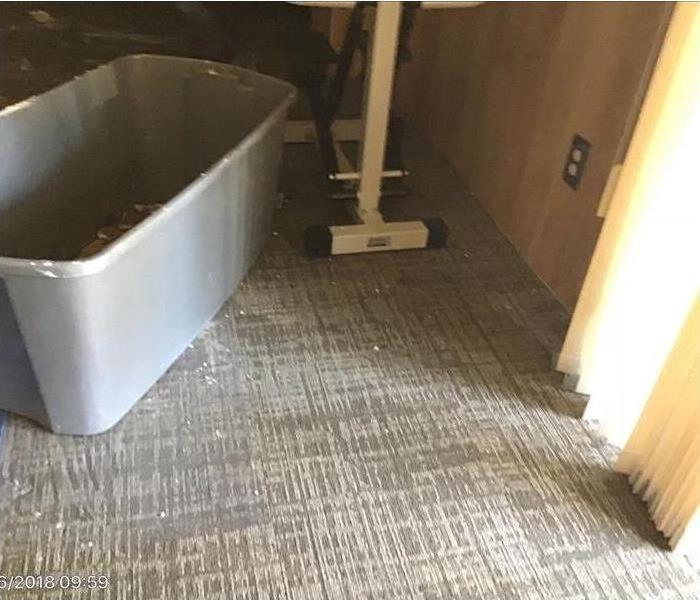Recent Storm Damage Posts
Prevent Burst Pipes this Winter: Essential Tips from SERVPRO
1/2/2025 (Permalink)
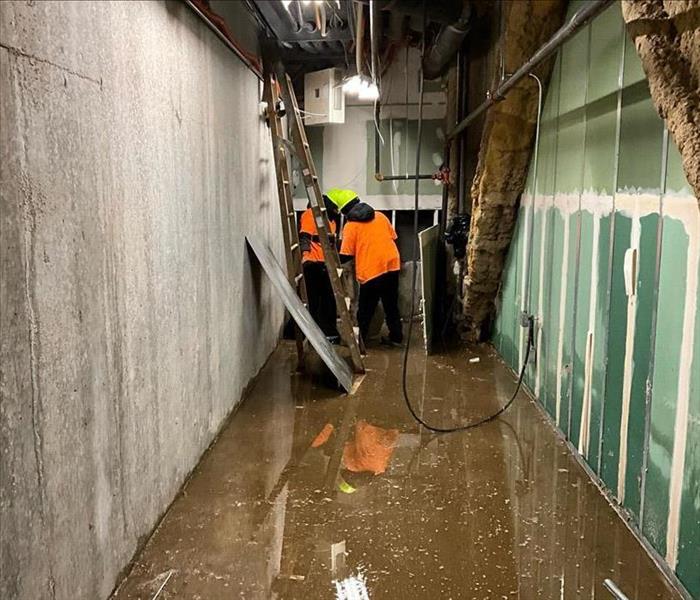 SERVPRO crews cleanup after burst pipes at a commercial property in Kansas City.
SERVPRO crews cleanup after burst pipes at a commercial property in Kansas City.
As temperatures begin to drop in the Kansas City Metro area, the risk of frozen pipes and potential water damage increases. With winter weather just around the corner, it's the perfect time to start preparing your home or business to prevent costly damage caused by burst pipes.
At SERVPRO of Olathe/Lenexa®, we understand how important it is to protect your property, and we’re here to provide you with essential tips to help you avoid frozen pipe disasters this season.
Why Are Frozen Pipes a Concern?
When water freezes inside pipes, it expands, creating pressure that can cause the pipe to burst. This can lead to major water damage, especially if the burst occurs in an area that’s difficult to detect, like in walls or ceilings. As the temperatures drop in Kansas City, especially during those cold snaps, the risk of frozen pipes becomes more significant. A burst pipe can flood your home, damage floors, walls, and personal belongings, and even lead to costly repairs that can be avoided with a little preventative care.
Tips to Prevent Frozen and Burst Pipes
Insulate Your Pipes
One of the best ways to protect your pipes from freezing is by insulating them. Pipes located in unheated areas such as basements, crawl spaces, attics, garages, and exterior walls are particularly vulnerable. Use foam pipe insulation or heat tape to wrap exposed pipes and help keep them warm. This simple step can make a huge difference in preventing pipe bursts.
Let Faucets Drip
During extreme cold spells, letting a small stream of water drip from faucets located on exterior walls can relieve pressure from freezing pipes. The moving water is less likely to freeze than water that remains still in the pipes. It also helps maintain the flow of water, preventing it from expanding and bursting the pipes.
Seal Cracks and Gaps
Inspect your home for gaps and cracks around windows, doors, and pipes that might allow cold air to enter. Seal any openings with weatherstripping or caulk to keep cold air from reaching your pipes. This is especially important in areas where pipes are exposed, as the cold air can rapidly lower their temperature and cause them to freeze.
Open Cabinet Doors
On colder nights, open the cabinet doors under sinks, especially in kitchens and bathrooms, to allow warmer air to circulate around the pipes. This is particularly effective for pipes located on exterior walls, where the risk of freezing is higher.
Maintain a Consistent Temperature
Avoid drastic temperature changes in your home. Keep your thermostat set to the same temperature day and night, even if you're leaving town. During particularly cold spells, it’s also a good idea to leave the heat on at a low temperature (around 55°F) if you’re planning to be away for an extended period. A sudden temperature drop inside your home can be enough to freeze vulnerable pipes.
Shut Off Outdoor Faucets
Drain and shut off water to outdoor faucets (hose bibs). Disconnect garden hoses and store them inside to prevent water from freezing inside the pipes connected to your exterior faucets. For extra protection, install insulated covers on outdoor faucets to help prevent freezing.
Know Where Your Main Water Shutoff Valve Is
In the event of a burst pipe, the faster you can turn off the water, the less damage you’ll experience. Make sure you know where your main water shutoff valve is located and how to operate it. If you’re unsure, take the time to locate it before the cold weather sets in.
Consider a Smart Thermostat
If you have a smart thermostat, set it to alert you if the temperature inside your home drops unexpectedly. This can help you take quick action before pipes freeze or burst. Some smart thermostats also allow you to adjust the temperature remotely, which can be helpful if you're away from home during a cold snap.
What to Do if You Suspect Frozen Pipes
Even with preventative measures, there’s always a chance that pipes could freeze. If you suspect you have a frozen pipe, it's important to act quickly:
- Turn off the water supply to your home immediately.
- Apply heat to the frozen area using a hair dryer, space heater, or warm towels. Avoid using open flames, such as a blowtorch, as this can cause a fire hazard.
- Check for leaks or cracks once the pipe has thawed. If you find any, it’s important to contact a plumber right away.
- Contact a water damage restoration professional like SERVPRO of Olathe/Lenexa and the Kansas City Metro if water has leaked into your home. We can help with water extraction, drying, and cleanup to prevent further damage.
SERVPRO Is Here to Help
If the worst happens and your pipes do burst, you can count on SERVPRO to help restore your property. We specialize in water damage restoration and are available 24/7 to assist with cleanup and recovery. Our team is equipped with advanced equipment and techniques to dry your home or business efficiently and thoroughly, minimizing further damage and restoring your property to its preloss condition.
Conclusion
Preventing burst pipes starts with proactive measures and attention to detail. By following these simple tips, you can avoid the hassle, stress, and expense that come with water damage this winter. And if disaster strikes, remember that SERVPRO of Olathe/Lenexa and the Kansas City Metro is always here to help.
Stay safe, stay warm, and don't let the cold catch you off guard. Let us be your partner in protecting your home or business this winter season!
Storm Damage Prevention Tips from SERVPRO® of Olathe/Lenexa
6/16/2024 (Permalink)
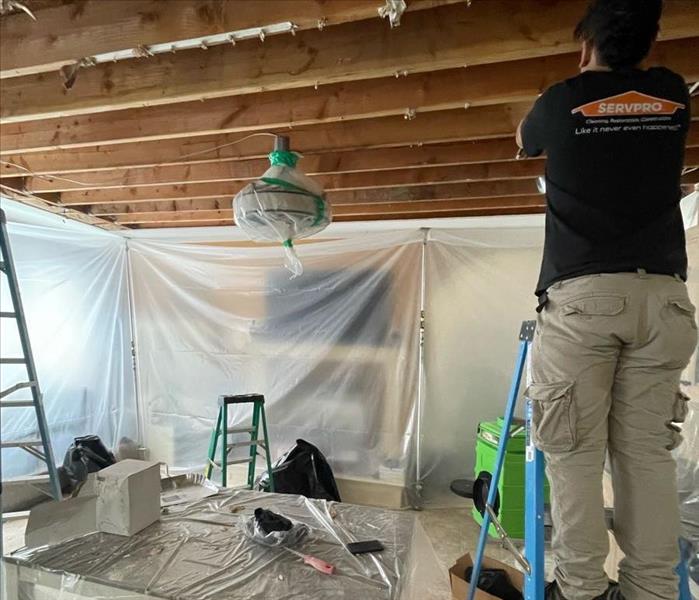 Large residential water loss, after storms leaves a home in need of mitigation and reconstruction.
Large residential water loss, after storms leaves a home in need of mitigation and reconstruction.
June marks the beginning of summer, but it also brings with it the onset of storm season. As residents of Olathe and Lenexa, we are no strangers to severe weather, which can lead to significant property damage if proper precautions are not taken. At SERVPRO® of Olathe/Lenexa, we understand the importance of being prepared for whatever Mother Nature throws our way. Here are some essential tips to help you prevent storm damage this June.
1. Inspect and Maintain Your Roof
Your roof is your home’s first line of defense against storms. Regular inspections and maintenance can prevent minor issues from becoming major problems.
- Inspect for damage: Look for missing or damaged shingles, and check for signs of wear and tear.
- Clean gutters and downspouts: Ensure they are free of debris to allow for proper drainage and to prevent water damage.
- Trim overhanging branches: This will reduce the risk of branches breaking and damaging your roof during a storm.
2. Secure Outdoor Furniture and Items
Strong winds can turn outdoor furniture, decorations, and equipment into dangerous projectiles.
- Anchor heavy items: Securely anchor items like grills, benches, and large potted plants.
- Store smaller items: Move smaller items such as patio furniture, garden tools, and toys indoors or to a secure location.
3. Check and Reinforce Windows and Doors
Windows and doors are vulnerable points in your home during a storm. Proper reinforcement can prevent significant damage.
- Install storm shutters: These provide extra protection against flying debris and strong winds.
- Use high-impact glass: If you live in a high-risk area, consider installing windows and doors with impact-resistant glass.
- Seal gaps and cracks: Ensure all gaps around windows and doors are properly sealed to prevent water infiltration.
4. Maintain Landscaping
Your yard can play a significant role in how well your home withstands a storm.
- Trim trees and shrubs: Regularly trim trees and shrubs to reduce the risk of branches breaking off and causing damage.
- Remove dead or dying trees: These are more likely to fall during a storm, posing a risk to your property and safety.
- Proper drainage: Ensure that your yard has adequate drainage to prevent water accumulation and potential flooding.
5. Prepare an Emergency Kit
Being prepared with an emergency kit can make a significant difference during and after a storm.
- Essential supplies: Include items such as water, non-perishable food, medications, flashlights, batteries, and a first aid kit.
- Important documents: Keep copies of important documents in a waterproof container.
- Communication tools: Ensure you have a charged mobile phone and a portable charger.
6. Develop an Emergency Plan
Having a clear plan in place can help you respond quickly and effectively during a storm.
- Evacuation routes: Know the safest routes out of your home and neighborhood.
- Communication plan: Establish a way to communicate with family members in case you are separated.
- Safe room: Designate a safe room in your home where you can take shelter during a storm.
7. Stay Informed
Keeping up-to-date with weather forecasts and warnings is crucial for staying ahead of storms.
- Weather alerts: Sign up for local weather alerts to receive timely notifications.
- Local news: Follow local news channels and weather services for the latest updates.
SERVPRO® of Olathe/Lenexa: Your Storm Damage Restoration Experts
Despite taking all the necessary precautions, storms can still cause unexpected damage. If your home or business suffers storm damage, SERVPRO® of Olathe/Lenexa is here to help. Our highly trained professionals are equipped with the latest tools and techniques to restore your property quickly and efficiently.
We offer:
- 24/7 Emergency Response: We are available around the clock to respond to your storm damage emergencies.
- Comprehensive Restoration Services: From water extraction and drying to structural repairs, we handle it all.
- Trusted Expertise: With years of experience in storm damage restoration, you can trust us to restore your property to its pre-storm condition.
Stay safe this June and remember, when disaster strikes, SERVPRO® of Olathe/Lenexa is just a call away. Contact us today for more information on our storm damage prevention and restoration services.
Tornado Alley: Understanding South Central Storm Risk
1/2/2024 (Permalink)
The South Central region of the United States is commonly referred to as "Tornado Alley" due to its susceptibility to tornadoes and other severe weather phenomena. This area, stretching from Texas to the Dakotas, experiences a unique combination of weather patterns that create a high risk for destructive storms. In this blog, we will explore the characteristics of Tornado Alley and provide valuable insights on understanding South Central storm risk.
Geographic Factors
- Tornado Alley encompasses a vast portion of the South Central region, characterized by a typically flat and wide terrain.
- Warm, moist air from the Gulf of Mexico collides with cooler, drier air from the Rocky Mountains, creating an unstable atmosphere that favors storm development.
- The region's positioning relative to the jet stream and its tendency to dip southward during certain times of the year further enhances the risk for severe storms.
Tornado Frequency and Intensity
- Tornado Alley experiences a disproportionately high number of tornadoes compared to other regions worldwide.
- The primary tornado season in Tornado Alley occurs from late spring to early summer, although tornadoes can occur at any time of the year.
- The intensity and destructive power of tornadoes in Tornado Alley can be significant, with some storms reaching EF3, EF4, or even EF5 on the Enhanced Fujita scale.
Storm Preparedness
- Due to the heightened risk of tornadoes in Tornado Alley, it is crucial for residents to have a comprehensive storm preparedness plan in place.
- Stay informed about weather conditions by regularly monitoring local weather forecasts, alerts, and warnings from meteorological sources and emergency management agencies.
- Create an emergency kit with essential supplies, including food, water, medications, a first aid kit, flashlights, and a weather radio.
- Identify and designate a safe shelter location in your home, such as a basement or an interior room on the lowest level, away from windows.
- Practice tornado drills with your family to ensure everyone knows what to do in the event of a tornado.
Community Resilience
- Local communities in Tornado Alley often have well-established storm response systems, including tornado sirens, emergency operations centers, and trained storm spotters.
- Stay connected to the local community by signing up for emergency alerts and participating in neighborhood watch programs or community preparedness initiatives.
- Support and engage in community efforts to improve storm readiness, such as attending severe weather workshops and volunteering with local response organizations.
Respect and Awareness
- While tornadoes can be awe-inspiring, it is vital always to respect the power and danger they present.
- Be aware of the signs of an approaching tornado, including dark, greenish skies, large hail, and a loud, continuous roar.
- During severe weather, stay indoors and take shelter immediately. Do not attempt to chase storms or put yourself at unnecessary risk.
Living in Tornado Alley comes with an inherent risk of experiencing severe storms and tornadoes. Understanding the geographic factors, tornado frequency, and storm preparedness are crucial for residents in the South Central region. By staying informed, prepared, and connected with the local community, you can enhance your resilience and safety in the face of South Central storm risks. Remember to always prioritize caution and respect for the power of severe weather phenomena.
The Unseen Impact of Storms on Kansas Homes and Properties
9/13/2023 (Permalink)
In the heart of the Great Plains, Kansas boasts a landscape that is both picturesque and diverse. However, the tranquility of this region can be disrupted by the unrelenting force of storms, which can leave a lasting impact far beyond what meets the eye. While the visible damage caused by storms is often evident, it's equally important to consider the unseen consequences that can affect homes and properties. In this insightful guide, we'll delve into the hidden aftermath of storms in Kansas and provide valuable tips to help homeowners navigate these challenges.
Structural Integrity
Storms, particularly those with strong winds and hail, can compromise the structural integrity of homes and buildings. Even seemingly minor damage to roofing, siding, or windows can lead to gradual deterioration over time, increasing the risk of leaks, moisture intrusion, and mold growth. Regular inspections by professionals can help identify and address these hidden vulnerabilities before they escalate into major issues.
Water Intrusion and Mold
Water intrusion is a significant unseen consequence of storms, and its effects can be pervasive. Moisture that seeps into walls, ceilings, or floors can create an ideal environment for mold growth, which poses health risks and can lead to extensive property damage. Homeowners should prioritize thorough drying after storms and consider professional mold inspections to prevent these hidden threats.
Electrical Systems
Storms can impact electrical systems in subtle yet dangerous ways. Power surges or lightning strikes can damage wiring, circuit breakers, and appliances. Homeowners should be cautious of flickering lights, outlets that no longer work, or burning odors, which may indicate hidden electrical damage. Consulting a licensed electrician for a thorough inspection can help ensure the safety of your home's electrical systems.
Foundation and Drainage
Excessive rain from storms can saturate the soil around a property's foundation, potentially leading to shifts, cracks, or settling. These issues may not be immediately apparent but can result in long-term structural problems. Ensuring proper drainage and gutter systems, as well as monitoring your foundation for signs of damage, is essential to preventing unseen complications.
Insulation and Energy Efficiency
Storms can impact insulation and energy efficiency, which may not be readily noticeable. Gaps or damage in insulation caused by wind or water can lead to increased energy consumption and discomfort. A professional energy audit can help identify areas where insulation and energy efficiency may be compromised, allowing homeowners to take proactive measures for improvement.
Landscape and Drainage
The landscape around your property plays a crucial role in storm impact. Poor drainage can lead to water pooling near the foundation, contributing to erosion and potential water intrusion. Regularly inspecting and maintaining your landscape features, such as grading, gutters, and downspouts, can help mitigate hidden storm-related risks.
Psychological Impact
Beyond the physical effects, storms can also have an unseen psychological impact on homeowners. Dealing with property damage, power outages, and safety concerns can lead to stress, anxiety, and emotional distress. It's important to prioritize mental well-being during and after storms, seeking support from friends, family, or professionals if needed.
As the skies over Kansas darken with storm clouds, it's vital to recognize the unseen impact that these weather events can have on homes and properties. By understanding the potential risks, conducting regular inspections, and addressing hidden consequences promptly, homeowners can navigate the aftermath of storms with greater resilience. Remember, while the visible damage may fade, the unseen effects can linger—taking proactive steps to mitigate these risks will ensure the safety, comfort, and longevity of your Kansas home.
What to Know and Do Before, During, and After a Mudslide
6/13/2023 (Permalink)
Mudslides are a common natural disaster that can occur after heavy rains, earthquakes, or volcanic eruptions. Mudslides can cause severe damage to homes, businesses, and infrastructure, and can be dangerous to individuals caught in their path. It's important to know what to do in the event of a mudslide to keep yourself and your loved ones safe.
Understand the Risk
The first step in preparing for a mudslide is to understand the risk in your area. If you live in an area prone to mudslides, it's important to be prepared and have an emergency plan in place. Make sure your family knows what to do in the event of a mudslide and has a designated meeting place. Keep emergency supplies on hand, including a first aid kit, water, food, and blankets.
Safe Location
If you're caught in a mudslide, it's important to move quickly to a safe location. Stay away from areas that are prone to mudslides, such as steep hillsides, canyons, and areas with loose soil. If you're driving, pull over to the side of the road and turn off your engine. If you're outside, move to higher ground or seek shelter in a sturdy building.
Prepare for a mudslide
While there is no guaranteed way to prevent a mudslide, there are several steps that homeowners can take to prepare for and mitigate the effects of this type of disaster. Firstly, it is important to identify whether your property is located in a high-risk area for mudslides. The United States Geological Survey (USGS) provides hazard maps that show the likelihood of mudslides occurring in certain areas, which can help homeowners determine their level of risk.
Minimize the Risk
Once you have identified that your property is at risk of a mudslide, you should take steps to minimize the potential for damage. This can include installing retaining walls or other forms of erosion control, ensuring that drainage systems are functioning correctly, and removing any trees or vegetation that are at risk of falling onto your property during a mudslide. It is also important to have an emergency plan in place and to keep an emergency kit on hand in case you need to evacuate your home quickly.
Immediate Action
If a mudslide does occur, it is crucial to take immediate action to ensure your safety. If you are in the path of a mudslide, evacuate your home immediately and move to higher ground. If you are unable to evacuate, move to an interior room on the ground floor of your home and stay away from windows and exterior walls. Do not attempt to drive or walk through a mudslide, as the debris can be extremely hazardous.
In conclusion, while mudslides can be devastating, there are steps that homeowners can take to prepare for and mitigate their effects. By identifying the risk of a mudslide, taking steps to minimize the potential for damage, and having an emergency plan in place, you can protect your property and keep yourself and your family safe. If a mudslide does occur, it is important to take immediate action to ensure your safety and work with a qualified disaster restoration company to restore your property. They can assist with debris removal, water damage restoration, and mold remediation. It's also important to take steps to prevent future mudslides, such as grading your property to divert water away from your home, planting trees and vegetation to help stabilize the soil, and installing retaining walls to prevent erosion.
How To Prepare Your Home for High Winds
12/4/2022 (Permalink)
How To Prepare Your Home for High Winds
Hurricanes, tornadoes, and other high-wind events can be devastating to your Shawnee, KS home. Even if you live in an area that’s not prone to extreme weather events, it’s important to prepare your home for high winds by securing your roof and windows and making sure you have the right coverage in case of any damage.
Remove Dead Trees.
Dead trees are more likely to fall on homes when high winds hit. If you have dead trees in your yard, hire a professional arborist to remove them as soon as possible.
Dead trees are also more prone to falling during high winds because they’re already weak and susceptible to breakage. If you notice that a tree is leaning or appears sickly, contact a tree company that specializes in removing dead trees before it’s too late! Dead trees can be not only an eyesore but also dangerous for your family—especially if you have small children running around outside on the ground level of your home!
Secure Your Roof.
The first thing you'll want to do is check your roof for any loose shingles or tiles. If they are still firmly attached, then you can leave them as-is. If they're not secure, however, you'll need to secure them somehow or else risk having them fly off in a high wind and hit someone (or something) below.
Next, walk around the perimeter of your house looking for any signs of water damage and leaks that may have occurred after a previous storm or heavy rains. Check all doors and windows to make sure they are properly sealed shut so that no water can enter through their openings. If there's any sign of water damage inside your home at all—even just small puddles on floorboards—you should contact an expert immediately so that repairs can be made before mold begins forming within those areas too!
Install Hurricane-Resistant Windows.
If you plan to stay at home during a hurricane, it is important that you install hurricane-resistant windows. The severity of the storm can be determined by the Saffir-Simpson Hurricane Scale (based on wind speed), with categories of one through five. A category three or four storm will do serious damage to an ordinary house, so it is essential that your window frames be strong enough to withstand these high winds.
These windows should have impact-resistant glass and frames that are securely fastened together. You don’t want them to blow away in the middle of the night when everyone else has evacuated their homes! If you already have hurricane-resistant windows installed around your home, now would be a good time to check them out and make sure they haven’t been damaged by previous storms or other natural disasters such as earthquakes or floods.
Read And Follow Your Homeowner’s Policy.
Keep in mind that not all damage is covered under standard policies—some things may be excluded from reimbursement entirely while others may require payment first out of pocket before any funds are reimbursed by an insurer. For example, Some exclusions exist like flood damage which won't be covered unless you buy a specific rider for floods."
Ensure You Have The Right Coverage.
It's important to check your insurance policy before the storm hits. Your insurer may have limits on coverage that could leave you with a hefty bill if something is damaged or destroyed in the storm.
You'll also want to ask about exclusions, especially if any of your possessions are particularly valuable. For example, many policies exclude coverage for damage caused by flooding, which can be devastating during a hurricane.
The terms and conditions of your policy are also worth checking over. Is there an aggregate limit (the total amount covered)? Is there a deductible? Be aware of these things so they don't catch you off guard after the fact!
You should protect your home from high winds and be properly covered if wind damage occurs.
If you live in an area that is prone to hurricanes, we recommend that you take basic measures to prepare your home for high winds. For example, if a tree falls on your home, the damage may be covered by your homeowner’s insurance policy. But if there are no trees in the way and it still gets damaged by high winds, then coverage might not apply.
If you don’t have a homeowner's policy yet or haven't reviewed your current one recently, get started now! You can also learn more about hurricane season by visiting our page on what to expect during this time of year.
Preparation and planning can help you get through a hurricane or other extreme weather event. It’s important to prepare your home for high winds so that it can withstand the forces of nature without any major damage. We hope this article has provided some helpful tips on how to keep your home safe from hurricanes, but if you need more information on how we can help protect your family against all kinds of natural disasters, please contact us today!
When Should You Call an Olathe Flood Damage Specialist?
8/11/2022 (Permalink)
 Our storm damage technicians have the equipment and experience to restore your property to pre-damage condition.
Our storm damage technicians have the equipment and experience to restore your property to pre-damage condition.
SERVPRO Helps Olathe Residents Deal with Flood Damage
If you notice minor flooding in your house, you might be tempted to deal with it yourself. After all, it might seem like a hassle to call out a flood remediation company for a small amount of water.
If you are wondering when to call a specialist to look at flood damage in your Olathe, KS home, the answer is “as soon as possible.” Even if you have mopped up visible water, there are still some associated flood damage risks:
- Wet materials such as carpets or wallpaper can provide a breeding ground for fungus.
- Depending on the water source, there is a risk of contaminants.
- Water can seep into walls and baseboards and cause damage to your home’s structure.
- Wall insulation may become waterlogged and need replacing.
SERVPRO trains our teams to deal with all of these issues and more. We can advise you on what to keep and what to toss away. We can also dry your home and belongings, apply microbial treatments, and deodorize your property.
How Property Managers Should Prepare for Hurricanes
5/24/2022 (Permalink)
Hurricane Preparedness For Property Managers
As a hurricane approaches, you need to do what is necessary to keep your Shawnee, KS, property and its renters safe. While a storm can seem unpredictable, there are some things you can do to limit hurricane damage to the premises.
1. Make a Hurricane Preparedness Plan
Planning ahead is essential. Every member of your team should understand his responsibilities before, during and after the storm. Remember that some of your workers may live in high-risk areas. They will understandably want to focus on their own homes prior to assisting your renters.
2. Get Your Renters Ready
You should also review and discuss your policies with your renters. This way, they will know what to expect from you ahead of time. Make sure your renters see your actions as evidence of your concern for their well-being.
Even if your renters are used to major storms, your guidance should help them feel more secure. Tell them about the different resources available, and remind them to gather essential supplies such as food and water. You should also give them contact information for the local hurricane damage restoration company.
In addition, tell your renters to purchase sufficient flood insurance. Flood coverage is not always included in a regular rental policy. Your tenants should thus understand that additional insurance may be necessary.
3. Take Inventory
You do not want to be scrambling to find important information in the middle of a storm. Before hurricane season begins, make sure you have emergency contact information for every renter. You should also check the agreements you have with pool companies, landscapers and similar contractors. Consider adding a priority clause to these deals so that your renters' needs will be handled promptly.
Preparing for a potential storm is a major part of property management. By following the above steps, you can prevent severe hurricane damage to your premises.
Why Do Shawnee Residents Trust SERVPRO with Flood Damage Repair?
2/18/2022 (Permalink)
How do SERVPRO techs extract excess water after flood damage to Shawnee homes?
Removing excess or bulk water is essential for decreasing the time needed to dry a building. SERVPRO techs rely on two primary ways to remove water after flood damage to your Shawnee property - extraction, and evaporation.
SERVPRO techs prefer extraction to remove bulk water first during flood damage restoration in Shawnee properties. The truck-mounted extractors that SERVPRO techs use can pull out about 100 gallons of water in one hour while it takes three days to remove the same volume by evaporation. While some water can be removed by draining ceiling cavities and HVAC duct lines, most need to be removed using pumps and extractors.
How do SERVPRO techs extract water from carpet and pad during flood restoration in Shawnee?
Once the technicians remove the bulk water, they use a moisture sensor to determine the moisture still present in the carpet and pads. SERVPRO techs also inspect the carpets for signs of delamination after flood damage. Delamination occurs when the primary and secondary backings of the carpet separate.
A carpet wand and deep extraction tool remove moisture from a wet carpet. Techs only use a deep extraction tool if the carpet is dried with the padding still in place. If the padding needs removal, a carpet wand is sufficient to extract most water from the carpet.
Do different carpets dry differently?
Carpets with light face weights are easier to dry than those with heavy face weights. Similarly, the carpets directly glued to the subfloor are quicker to dry than carpets stretched over a pad. That said, SERVPRO techs use a combination of extraction tools, air movers, and dehumidifiers to dry almost any type of carpet.
Call SERVPRO of Olathe / Lenexa and SERVPRO of Blue Valley at (913) 782-4693 for fast and efficient service.
Need Help to Deal with Flood Damage in Olathe? Call SERVPRO
2/3/2022 (Permalink)
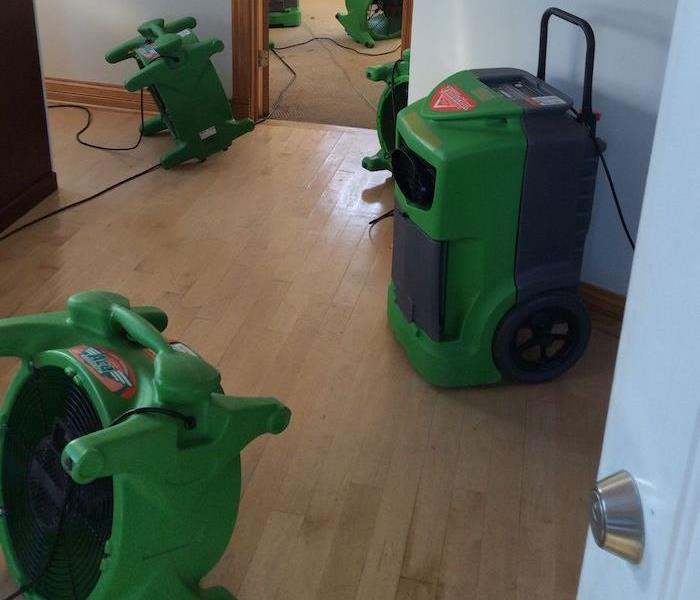 Looking for a restoration company? Look no further, SERVPRO of Olathe / Lenexa and SERVPRO of Blue Valley is here for you.
Looking for a restoration company? Look no further, SERVPRO of Olathe / Lenexa and SERVPRO of Blue Valley is here for you.
SERVPRO Techs Have a Scientific Approach to Mitigate Flood Damage in Olathe
Containing microbial growth after flood damage to your Olathe home is one of the biggest challenges for restorers like SERVPRO. While the application of antimicrobials can undoubtedly help, it is not an effective method when used alone.
SERVPRO techs limit the microbial growth after flood damage to your Olathe home by speeding up the drying process and removing the contaminated material. Antimicrobials are applied only once these two steps are done. This multifaceted strategy ensures that the microbial population is contained and there is a minimal risk of the microbes returning after the professionals finish the restoration.
SERVPRO Techs Use Professional Products During Flood Restoration in Olathe
SERVPRO techs apply antimicrobial products after the initial water extraction to control microbes in your Olathe home. We take utmost care while using these products to prevent any undesired effects for workers.
We only use EPA-registered broad-spectrum disinfectants to prevent the growth of various microbes, including bacteria and fungi, after flood damage to your property due to a storm. Once the drying goal is reached, the product is usually applied to the subfloor, tackles strip, walls, and wall bottom plates. SERVPRO techs use several classes of chemical disinfectants, including:
- Phenolics
- Chlorines
- Quaternary compounds, and
- Botanicals
What Precautions do SERVPRO Techs Take While Applying Antimicrobials?
SERVPRO techs always conform with applicable federal, state, and local regulations and laws when using chemical disinfectants. Our professionals always wear personal protective equipment when dealing with disinfecting chemicals. We also brief the customer about the product used following the IICRC S500 guidelines. The disinfectant is applied only after obtaining the customer’s informed consent of product use.
Call SERVPRO of Olathe / Lenexa and SERVPRO of Blue Valley at (913) 782-4693; we are available round the clock to answer your questions.
Can Lenexa Flooding Cleanup Occur During Snowy Conditions?
1/11/2022 (Permalink)
SERVPRO Prepares for All Types of Basement Flooding Water Removal Services in Lenexa
Because precipitation is frozen does not change the necessity of storm flooding cleanup in Lenexa. Plunging temperatures and snow cover can make water removal services tricky. Still, our certified and well-equipped crews have seen it before and bring their training and experience to restore water damaged areas in your home.
How Does Flooding Occur During Winter Storms in Lenexa?
Fierce winds can bring debris crashing onto roofs or into siding during an ice storm or blizzard in Lenexa. It takes no time for a leaking roof from storms to develop when the slush and snowmelt encounter warmer interior air.
A cozy snow cap can hide treacherous ice dams along clogged gutters and roof edges, sometimes leaking days after the storm once a few melt and refreeze cycles force water through cracks in shingles or under poorly adhered flashings.
Sub-freezing temperatures cause inadequately insulated pipes, especially on exterior walls, to freeze and crack, flooding into lower levels of Lenexa homes.
Ice and snow buildup around foundations can create “moats” of liquid water as the temperature increases. This rising water can drain into the basement of your home.
What Strategies Does SERVPRO Use to Mitigate and Remediate Cold Weather Flooding?
SERVPRO Institute of Inspection, Cleaning and Restoration Certification (IICRC)-trained crews assess and plan for flooding cleanup following industry best practices. To mitigate further leaking from the roof and snowpack, our teams spend time clearing ice and snow, channeling meltwater away from the interior of your home. Basement water cleanup includes:
- Pumping and extracting, using SERVPRO’s truck-mounted or portable equipment as circumstances indicate
- Tracing water migration with moisture detectors to ensure we find and release trapped water
- Configuring heaters, air movers, and dehumidifiers to normalize moisture levels
Winter storms do not deter SERVPRO of Olathe / Lenexa and SERVPRO of Blue Valley. One call to (913) 782-4693 brings highly qualified restorers to your home up to the challenge of removing both frozen and liquid water.
Water Restoration and Repairs Olathe Homes Need During Cold Snaps
12/2/2021 (Permalink)
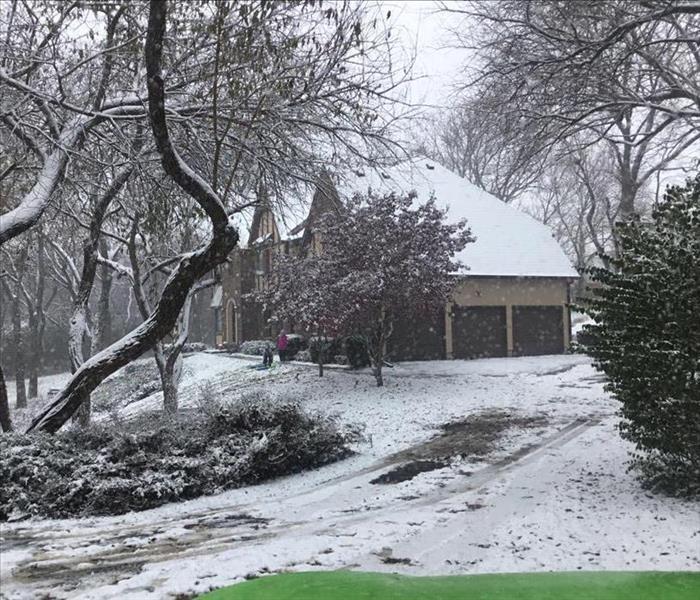 SERVPRO says to be prepared to prevent frozen pipes, ice dams on the roof, and water damage in Olathe. Call us for advice now, or restoration later
SERVPRO says to be prepared to prevent frozen pipes, ice dams on the roof, and water damage in Olathe. Call us for advice now, or restoration later
We provide fast and efficient mitigation and restoration for Olathe homes after water damage.
The winter months usher in several costly and destructive threats for your home in the form of freezing pipes or intruding snowmelt. No matter how your property becomes affected, our SERVPRO team is Here to Help.
Frozen Pipes Burst or Leak
The need for frozen pipes and ice damming cleanup in Olathe homes is not all that uncommon, with severe temperature drops and the city's placement near significant water bodies like the Missouri River. Frozen pipes create immediate issues for households, making responses for extraction and mitigation vital from our experienced team. We make it a priority to:
- Re-establish water service
- Repair damaged plumbing
- Prevent continued damage
Can This Water Damage Be Prevented?
It is possible to reduce or eliminate the possibilities of frozen pipes and the subsequent resulting damage. Insulating exposed plumbing is an excellent start to protecting your lines. Foam tubing and tape are common materials to shield pipes from cold air. Other solutions include maintaining warmer temperatures in your house during cold snaps and not shutting off your heat if you leave for extended periods in the winter months.
Ice Damming Along Roof Edges
Ice damming can be a threatening situation for your residence. The buildup of ice on the eaves of the roof can allow snowmelt to force its way back underneath shingles and into your attic space. When these situations occur, our experienced professionals can work to both repair the damage to the roof materials while managing the water with equipment like:
- High-pressure pumps
- Wet vacuums
- Air movers
How Can This Emergency Be Prevented?
While you can do little to affect the weather conditions outside your home, there are steps that you can take to help reduce the possibilities of ice buildup along the eaves of your roof. The first and most effective is installing heated cables along the most susceptible areas to prevent any ice. Secondly, you can ensure that the attic's insulation against the roof is sufficient and devoid of gaps, and capable of preventing warm air leakage that can cause snowmelt on the roof.
Sometimes winter damage cannot be avoided, so you must rely on efficient and knowledgeable restoration professionals like our SERVPRO of Olathe / Lenexa and SERVPRO of Blue Valley teams. We offer effective mitigation and restoration solutions for recovering situations like burst pipes or flooding during extreme winter weather events. Give us a call today at (913) 782-4693.
How Can Flood Water Damage Your Olathe Basement?
10/8/2021 (Permalink)
The Lowest Level Of Your Olathe Home Is a Target For Flood Damage Which Can Be Destructive To Exposed Elements.
Flooding is more common in Olathe homes and businesses than you might believe. Surges from torrential rains or tornado damage can leave properties vulnerable to water penetration. Cleaning and restoring the basement level is an urgent need for damaged homes after flooding.
Extraction for Natural Floodwater
Our technicians must start extraction work before the debris and solids making up the flood damage in Olathe homes can be addressed. Our professionals have powerful water removal tools from wet vacuums to truck-mount extractors for this purpose.
Thorough Inspection To Direct Restoration Work
One of the ways that we can learn about the current conditions of exposed building materials, contents, and other concerns is through a complete inspection of the property. Our crew chief or qualified administration division meets with the customer and walks through the house to catalog loss and pre-existing conditions. This assessment helps discover:
- Structural Compromise – We look for distinct damage to structural elements that could ultimately collapse or fail. We can offer controlled demolition services during the mitigation phase.
- Potential Contamination – Natural flooding can welcome possible contaminants and pathogenic threats to the property from exposures to decaying organic matter, sewage, and other harmful substances.
- Moisture Damage – Lingering water damage can also have far-reaching effects on the entire property if not resolved as soon as possible. We use moisture detection equipment to achieve these results.
Natural disasters can be destructive and devastating for homes in their path. When flooding impacts area properties, many basements and lower portions of split-level homes suffer standing water and possible contamination. Our SERVPRO of Olathe / Lenexa and SERVPRO of Blue Valley teams understand the urgency of this situation and respond 24/7 to help when you need it most. Call us today at (913) 782-4693.
Can Olathe Homeowners Remove Flood Damage Odors?
8/2/2021 (Permalink)
 Our Olathe area customers breathe a sigh of relief when our SERVPRO team arrives for storm damage cleanup and restoration
Our Olathe area customers breathe a sigh of relief when our SERVPRO team arrives for storm damage cleanup and restoration
Olathe SERVPRO Odor Control Technicians Have the Tools to Eliminate Flood Damage Smells
Storms and floodwater leave behind innumerable damages in their wake. One in five flood events happen outside of a high-risk flood zone, and 98% of US counties have been impacted by flooding. Even when Olathe homeowners are prepared for potential flood damage, the effects–including unpleasant odors from debris and microbes–can be difficult to remove without professional assistance.
SERVPRO technicians can remediate storm and flood damage affecting Olathe homes 24/7, including weekends and holidays. Flood response can begin in as little as several hours after a homeowner’s initial contact.
SERVPRO Flood Damage Odor Control with Industrial-Grade Deodorizers
While several products, such as EPA-registered biocides and HEPA-filter vacuums aid in odor control, Olathe SERVPRO Odor Control Technicians (OCTs) also utilize deodorizer units to address widespread flood damage malodors in a home.
Ultra-low volume (ULV) foggers, which are frequently deployed for storm and flood odor control, work as follows:
- The fogger is used to dispense water or solvent-based deodorizing agents, which generate microscopic deodorant particles
- Deodorizer particles penetrate odor-affected surfaces
- Deodorizer molecules combine with and eliminate odor-causing particles
Technicians use commercial-grade drop cloths to protect furnishings from potential secondary moisture damage during wet fogging.
SERVPRO of Olathe / Lenexa and SERVPRO of Blue Valley can be reached at (913) 782-4693 to provide cleanup services that can make a home look and feel, “Like it never even happened.”
Who Should Lenexa Residents Contact for Flood Damage Restoration?
5/13/2021 (Permalink)
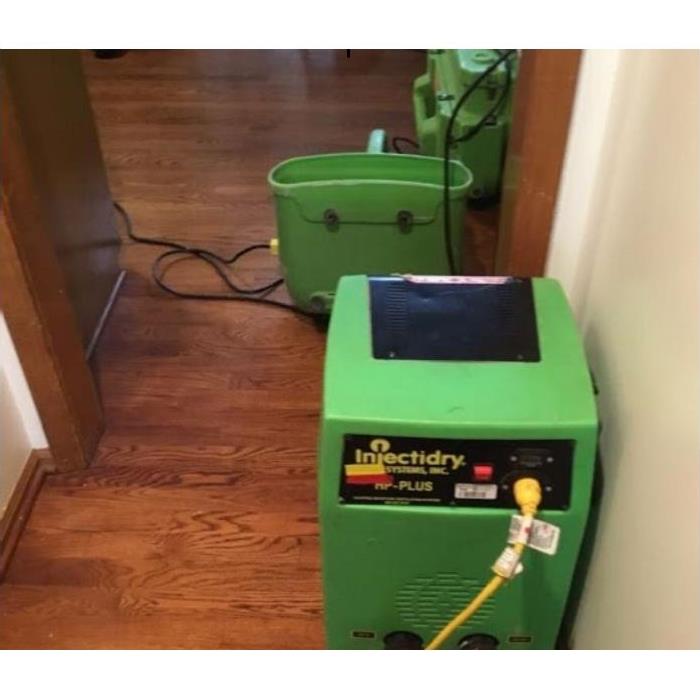 Do you know how to dry and restore water damage? SERVPRO does! We are always on call!
Do you know how to dry and restore water damage? SERVPRO does! We are always on call!
SERVPRO is a Lenexa-based Flood Damage Restoration Provider
Flooded properties that are the result of storms involve contaminated water supplies. These contaminants in water can come from sewer backup, road overflow, flash flooding, dirt, or debris. We are an experienced restoration service that provides:
Blackwater is frequently a part of flood damage in your Lenexa home and can release unpleasant odors or sewer gases. Activated oxygen units can help to eliminate these odors by using unstable ozone gas. Often, activated oxygen is used in enclosed areas such as basements or if inhabitants of the property are temporarily relocated.
- Property must be completely dry before operating activated oxygen; otherwise, bleaching can occur.
- Rooms that are being treated with activated oxygen are usually sealed off to prevent dissipation.
- A high-velocity fan can be used afterward to disperse ozone quickly and return your home to a safe space.
Tackle odor efficiently. Contact SERVPRO of Olathe / Lenexa and SERVPRO of Blue Valley for flood damage at (913) 782-4693.
Pondering What Type of Flood Damage You Might Face in Your Olathe Property
4/15/2021 (Permalink)
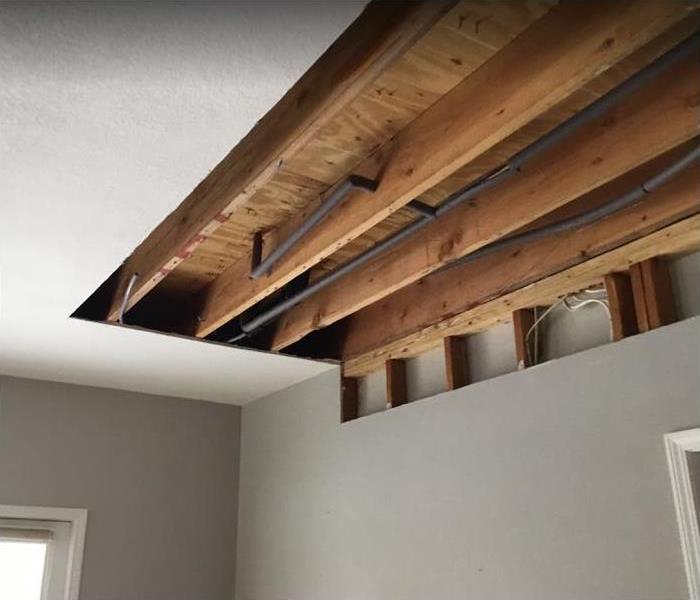 Sometimes storm water damage requires us to repair ceilings. But no worries! SERVPRO can make it "Like it never even happened."
Sometimes storm water damage requires us to repair ceilings. But no worries! SERVPRO can make it "Like it never even happened."
For Resolution of Any Category of Flood Restoration in Olathe, Call SERVPRO
Strong winds and torrential rainfall are expected during storms increasing the chances of houses flooding. For instance, if the winds tear off roofing materials, rainwater can enter, inundating the house. Alternatively, rising groundwater can reach the interior sections of the house. The resulting flood damage from such intrusion also varies, necessitating a quick response to address various situations that might arise, including:
- Biohazard remediation
- Sewage cleanup
- Water cleanup
- Ceiling Repairs from Water Damages
One easy way to deal with flood damage issues in Olathe is by hiring a professional restoration company. SERVPRO has technicians trained in different fields, including Water Restoration, Applied Microbial Remediation, and Applied Structural Drying, to handle any issues that arise.
Apart from structural damage, contents like furniture and floor treatments are affected by the floodwaters. Our SERVPRO team also includes Rug Cleaning Technicians, Upholstery & Fabric Cleaning Technicians, as well as Repair & Reinstallation Technicians who can help address the damage to your contents.
SERVPRO of Olathe / Lenexa and SERVPRO of Blue Valley have sufficient technicians to identify and resolve any flood damage-related issues. Call us at (913) 782-4693.
Can Storm Damage Be Prevented in Olathe Properties?
2/22/2021 (Permalink)
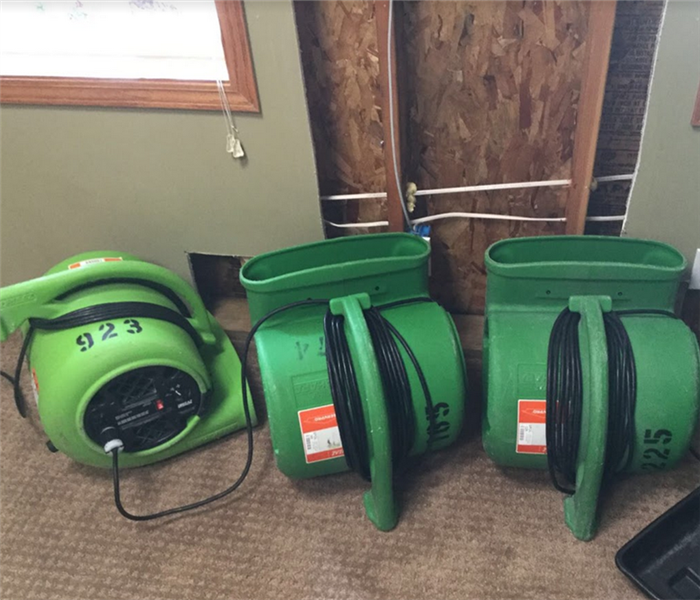 Call SERVPRO of Olathe / Lenexa today at (913) 782-4693 if you need help with professional storm damage restoration.
Call SERVPRO of Olathe / Lenexa today at (913) 782-4693 if you need help with professional storm damage restoration.
SERVPRO Brings Experience to Flood Damage Mitigation in Olathe
Kansas is but one of many states included in the infamous "Tornado Alley," and the state has a rating as a high-risk area for experiencing tornadic events, which can also bring flash flooding to the area.
While there is very little that can be done to avoid a tornado, flood damage in Olathe can get minimized through some actions by homeowners such as:
- Making sure the grade directs water away from the property
- Keeping gutters on the home cleaned
- Repairing weathered seals around the exterior
When flood water enters a home, it is crucial to bring in professional assistance. The water may appear to recede as quickly as it entered, but it can leave behind a host of problems such as deterioration of building materials, foul odors, and contaminants. SERVPRO technicians have the professional equipment and cleaning agents for restoring the home to a sanitary state for habitation.
SERVPRO of Olathe / Lenexa and SERVPRO of Blue Valley at (913) 782-4693 has access to the top equipment to handle flood damage in Olathe properties and make it "Like it never even happened."
Slow Down This Black Friday With a Step Back in Olathe History
11/23/2020 (Permalink)
Enjoy the 1860s with a living history lesson and tailored events dating back to Olathe's founding.
The Mahaffie House is one of the most recognizable historic properties in this region of Kansas, as it was once the primary supply location for those headed west along the Oregon Trail. It is fitting that this entire property will transform into a living piece of history on the day after Thanksgiving, showing how things might have looked back in the 1860s.
There are multiple fun activities and sites to behold when stepping away from the hustle and craziness of Black Friday for a simpler time. Some of what you can expect includes:
- Stagecoach ride
- Tour of the historic Mahaffie House
- Agricultural and farming exhibits
- Cookstove and blacksmith demonstrations
- Unique gifts for holiday shopping
Just like in 1860, severe weather does not wait for a convenient time to strike. Our SERVPRO of Olathe / Lenexa team can help with intense storm damage cleanup for Olathe homes when you call (913) 782-4693.
My Basement is Flooded, What Can I Do?
8/20/2020 (Permalink)
Olathe Homeowners Can Get the Flood Damage Help They Need by Calling SERVPRO After a Storm.
Basements tend to flood first during heavy rainfall because they are the lowest point of the home. Whenever you get hit with the unexpected, SERVPRO is available 24/7 for your Olathe property's emergency restoration. Our rapid response ensures that your personal property and structural materials have the best chance of full recovery.
Why Did My Basement Get Overloaded with Water?
With excessive rain during a storm, over saturation of the ground can lead to hydrostatic pressure. This occurs whenever moisture around the exterior of your basement or foundation will exceed the interior's pressure. Once this happens, water seeks lower pressure that can result in cracks and foundation leaks. We can address the issues you have with flood damage in Olathe to clean up standing water and dry out your basement interior.
What Happens During Flood Water Removal?
We use a broad assortment of treatments to restore your home to preloss condition. This may include:
- Rapid, efficient water removal using pumps and extractors to inhibit water from creating secondary damage and harm to your structural elements.
- The use of proprietary products and methods for restoration.
- Industrial-strength equipment and tools like dehumidifiers and air movers to bring moisture levels down.
- Controlled demolition, if required, to remove unsalvageable materials to be replaced with all-new materials.
- Thorough cleaning and sanitizing of all surface areas with EPA-registered cleaning agents.
- Complete documentation of all belongings disposed of or removed for off-site cleaning and drying.
Flood damage throughout your basement is a destructive event best left to skilled technicians for restoration. SERVPRO of Olathe/Lenexa and SERVPRO of Blue Valley is the team to call for reliable emergency service. Contact us when you need a crew deployed for water removal at (913) 782-4693. We’re Faster to Any Size Disaster!
More information about Olathe.
How Can I Handle this Flooding in My Basement?
7/7/2020 (Permalink)
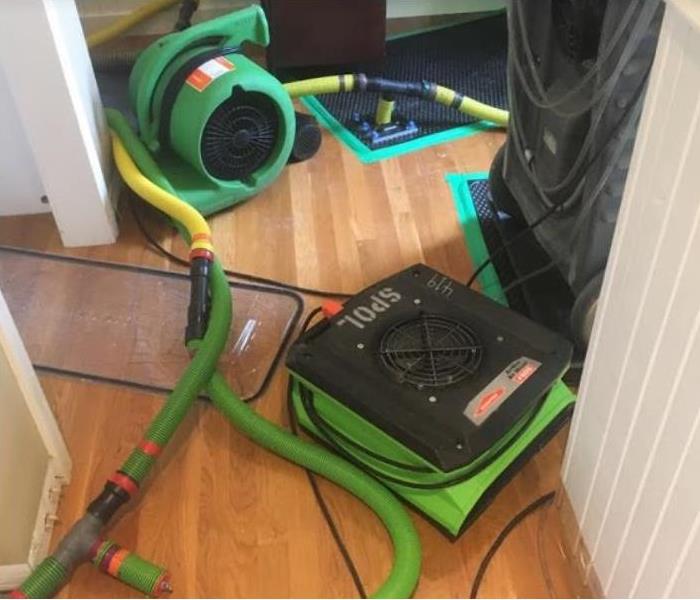 When storms cause water to enter your basement, call SERVPRO! We are always on call.
When storms cause water to enter your basement, call SERVPRO! We are always on call.
SERVPRO Offers Partial and Full Move Out Services When You Have Flood Damage Lurking in Your Olathe Basement
Flooding in a basement is a common issue that many homeowners face at one time or another. Even a smaller-scale flood can present with high-level damages, so calling in SERVPRO to help is the best way to get results. We can be at your Olathe property in as little as a few hours after receiving your call to begin the assessment and restoration phases.
Why is a Move Out necessary?
When you have flood damage in Olathe from a storm where water infiltrates your basement, it is often necessary to pack up and move out items so that our crew can get to work. We always carefully inspect and inventory all belongings we pack up to have a detailed listing of what items get moved where.
SERVPRO works to manage the job so that you have the most cost-efficient results. For example:
- We often clean contents before moving them to a staging area, which may reduce the time and cost needed for the project.
- We identify any items that are unsalvageable because of floodwater. All articles, even if disposed of, get logged for your records.
What Type of Damage Might Be Present?
There are several ways that floodwater may impact your interior, including:
- Overloading of your waterproofing system
- Damage to your foundation
- Potential mold and mildew growth
Floodwater contains a variety of contaminants, including chemical runoff, pests, and sewage. Our technicians treat the area with EPA-registered agents and biocide solutions that help inhibit microbial proliferation.
We are available 24 hours a day to assist you with flood damage. Call SERVPRO of Olathe/Lenexa and SERVPRO of Blue Valley at (913) 782-4693 to send a team out to get to work promptly.
More about Olathe.
How Does So Much Water Get into My House During a Minor Summer Storm?
6/4/2020 (Permalink)
 Olathe residents are relieved when they see the green service vehicles of SERVPRO to rectify their storm damage.
Olathe residents are relieved when they see the green service vehicles of SERVPRO to rectify their storm damage.
SERVPRO Helps Evaluate the Cause of Olathe Storm-Related Flood Damage as We Mitigate and Remediate Current Issues
The professionals we send to your Olathe home are prepared to assess your flooding issues and create a mitigation and remediation plan. Our goal is to make your current crisis "Like it never even happened." We also want to work with you to discover the underlying problem, helping you determine how to manage or eliminate the malfunction that caused the flooding to enter your home.
It Was Just a Gentle Rain! Why Is There Flooding in My Basement?
Flood damage in Olathe can stem from an accumulation of water over several days or periods of rain. The ground next to your foundation becomes saturated, and the water's pressure eventually causes seepage into your basement. Homeowners have some strategies available to minimize this effect, and they are not necessarily difficult or costly.
How Can I Direct Water Away from My Foundation?
SERVPRO suggests two proven strategies to keep water in your yard and out of your home that are worth trying.
Well-Functioning Gutter and Downspout System
- Review the condition of your roofline's drainage system. Gutters should be:
- Sound and installed at the proper angle to send the water dripping off the roof to the downspouts.
- Downspouts must be firmly attached to the home structure and have extensions that release the water more than ten feet from the foundation of the house.
Appropriately sloped soil adjacent to the foundation:
- The fill next to your house should slope down and away.
- Any plantings next to the house should be checked for hidden erosion of the soil, causing water to drain into the foundation.
We are committed at SERVPRO of Olathe / Lenexa to helping our customers not only solve the immediate flooding crisis but also adapt things in your home environment to prevent the damage from recurring. Call us 24/7 at (913) 782-4693 for short term fixes and long-term solutions.
What Could Happen After My Olathe Roof Leak?
5/23/2020 (Permalink)
Our Professionals Can Help to Identify Flood and Moisture Damage After Storm Losses at Your Olathe Home.
One of the most challenging aspects of water damage that comes through the roof of your Olathe home is not knowing how widespread the problem has become. A leak in the roof can persist for weeks or even months before you recognize some of the signs of a problem. Between our restoration specialists and our experienced in-house contractors, we can offer a comprehensive approach that addresses these concerns starting as soon as we arrive.
Roof leaking can be a destructive situation, especially considering that structural deterioration and weakening can be one of the long-term storm damages in Olathe homes after powerful weather events. Our SERVPRO professionals can evaluate the extent of this damage and what can get done to limit controlled demolition, reinstallation, and prolonged restoration practices that might be necessary.
How Do I Know Roof Damage Has Occurred?
Recognizing a problem might not always be as straightforward and simple as you might have thought. In many situations where small breaches in your roof have formed, water might not pour into your home, leaving a much slower spread to the damage. The drawback of not immediately recognizing a threat is how long materials can remain exposed to flood damage without drying. Some indicators can show you when your roof might potentially be leaking. These include:
- Spotting – Spotting is a sign that microbial growth might have begun on surfaces like drywall and ceiling tiles. The only way that this can occur is with more than 48 hours of moisture exposure, which can show that a leak has persisted longer than you might have realized.
- Structural Breaches – Other damages to your home after a storm can often also indicate the possibility of punctures or missing shingles on your roof. You should inspect your roof or attic space as soon as possible if you believe structural damage might exist.
- Sagging Materials – Water saturating through the unfinished floor of your attic can impact the ceiling system materials, including both drywall and insulation. When these items get heavier, they can begin to sag under the weight.
What Emergency Services Can Help Roof Damage?
Our professionals understand the value of beginning repairing damages to your roof or cleaning up flooding as soon as possible. Emergency services might indicate many of the immediate tasks that our SERVPRO team complete upon arrival, and several of these include:
- Roof Tarping – Tarping breaches or openings in the roof can prevent further water penetration so that our technicians can get to work on drying your home.Tarping is temporary, and our contractors can later fully restore and repair the roof.
- Board Up – When strong winds break windows or remove siding or plywood from the sides of your home, board up is a vital service to keeping your property from getting more heavily damaged by wind-driven rain or hail damages.
- Extraction – Many tools can help with the extraction in your home, and this is a common need when roof damages are considerable enough to allow for direct runoff into your house. With the use of submersible pumps and vacuums, we can gain control of standing water before it becomes more of a threat to the rest of the house.
- Positive Pressure Systems – Wall and ceiling cavities can hold onto water after roof damages, so much that you might not recognize a problem until it begins to breach the surface layers. Positive pressure systems allow for direct infusion of warm, dry air into structural openings to promote evaporation.
Why is Attic Flooding So Destructive?
Flooding in your attic is one of the most troublesome locations for this damage because you might not realize that the problem exists before it is a substantial threat. There are three primary reasons that flooding in the attic space can be a costly and threatening situation for the rest of your house. These include:
- Water migrating into other areas and lower levels of your house.
- The development of mold and fungal colonies.
- Prolonged exposure of structural elements can lead to collapse.
Can SERVPRO Rebuild After Restoration?
While many restoration teams require you to pursue your own contractors after a restoration has occurred, our SERVPRO team can offer a comprehensive approach that includes both the mitigation and the reconstruction that your property needs. This seamless transition between restoration and rebuilding reduces the time and money involved in the recovery of your house.
As much as flooding and roof damages can be a considerable challenge and obstacle in your home, our SERVPRO of Olathe / Lenexa team can help. We have experienced technicians with cutting-edge equipment that can make it “Like it never even happened.” Give us a call today at (913) 782-4693.
When Storms Strike
4/15/2020 (Permalink)
Catastrophic weather doesn’t wait for a convenient time to strike. Weather is unpredictable, which is why SERVPRO of Olathe / Lenexa is available around-the-clock to handle your crisis. The moment a storm hits your home or business is the moment you need to give us a call so we can begin our restoration process. Secondary damage strikes fast and can add additional repair time and expenses. That is why we don’t waste any time dispatching our skilled Storm Damage Specialists.
Disaster Recovery Team
There is no disaster too large or too small for SERVPRO of Olathe / Lenexa. From tornadoes to hurricanes, our Disaster Recovery Team has handled it all. We have experienced Project Managers on standby - they are ready to travel to take care of you. In large disasters, a centralized headquarters is established to coordinate their Disaster Recovery Initiative. SERVPRO Green Fleets are around the country and have some of the best heavy-duty equipment and products to begin restoring your home or business.
Inspection and Assessment
The type of storm or disaster determines what actions we need to take and what equipment we use. Tornadoes and torrential rains can cause severe water damage. Lightning strikes can cause devastating house fires. When you call us, one of our representatives gets an idea of what type of support you need and dispatches a team that is prepared to handle your crisis. Once your Project Manager and crew is onsite, they immediately assess the damage so everyone can get started.
All damages are thoroughly evaluated, and depending on the extent of damages; you may be required to relocate during the restoration process. Your Project Manager and crew handle everything needed to complete a quick and organized move-out process. Once everything is secure, and out of the way, the cleanup process can begin.
Water Removal
In the Midwest, it’s not uncommon for water damage to occur when storms hit your home or office. If water damage is discovered, we quickly begin our water extraction process. Our crews at SERVPRO of Olathe / Lenexa are well-prepared with on-hand equipment such as powerful wet/dry vacuums, which can quickly extract water. When exposed to moisture, mold can grow rapidly. Extracting water right away can help prevent mold damage. After eliminating as much water as possible, we use our high-powered air movers and fans. State-of-the-art drying and dehumidifying techniques can help give your home or office healthy and clean results.
Handling your Personal Belongings with Care
When large storms strike, you’ve likely watched as news helicopters fly over businesses and homes that endured significant destruction. Open roofs and sides of structures are often completely exposed, as you see personal belongings blown throughout the home and yard. Rest assured, the construction of your home isn’t our only priority - the loss you’ve suffered is often much more personal.
At SERVPRO of Olathe / Lenexa, we strive to preserve your items. Personal possessions, including antique or vintage items, are something that you never want to part with. We do our best to restore irreplaceable photographs and documents using one or more advanced drying and dehumidification processes. By using licensed experts, we have found that family heirlooms, antiques, and many other valuables are often able to be restored. The loss you feel after a catastrophe is hard enough - our goal at SERVPRO of Olathe / Lenexa is to minimize the magnitude of that loss for you and your family.
Contents Claim Inventory Service
If you haven’t ever dealt with an insurance company, it isn’t a simple process. Homeowners insurance requires a detailed list of your contents and their value, along with a report that outlines the damage and extent of the loss. Having assistance with this can help speed up your claim process. Using our Contents Claim Inventory Service, we walk room-by-room to ensure that we can provide your insurance company with detailed documentation. Our job is to ensure that you have the assistance you need when you need it the most.
No Lingering Odors
By the time we are complete, there should be no remnants of storm damage - including odors. We do a comprehensive and meticulous job when we deodorize and sanitize your home. It takes commercial-grade antimicrobial and antibacterial cleaners and disinfectants to clean up properly. Odor Control Technicians can leave your home permanently smelling fresh.
Restoration
The time has come for your home to come back together. Depending on what is needed, we oversee and handle all the repairs that need to be completed. At SERVPRO of Olathe / Lenexa, there is a crew available for every job. We can complete large projects such as rebuilding rooms or lining up a licensed and experienced roofer to install a new roof. Whether you need new flooring, windows, drywall, or cabinets – we can handle it all.
As we walk away from your completed home or business, we want to ensure that you are satisfied with a job well done. We pride ourselves on being hard-working, skilled, and friendly. At SERVPRO of Olathe / Lenexa, the relationships we form with you are equally as important as the jobs we complete. The person who once was your dedicated Project Manager likely has become a strong supporter and friend.
From disaster to delight - maintaining a positive relationship with our customers while getting the job done right is why we are called upon time and time again.
We Have the Flood Water Removal Techniques You Need for Results in Kansas City
3/17/2020 (Permalink)
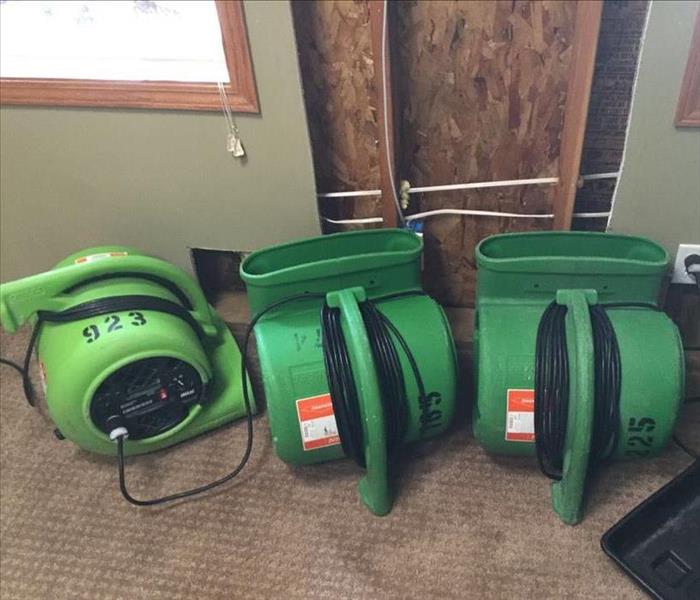 Flood damage can take over, let SERVPRO help you get your Kansas City home under control.
Flood damage can take over, let SERVPRO help you get your Kansas City home under control.
Kansas City flood damage ? SERVPRO will get the job done right.
Any number of emergencies can happen within your home. However, flooding and water damage is often something most homeowners mistakenly try to tackle on their own. This is the type of restoration project that is at the highest level in terms of emergencies, so it calls for the help of skilled technicians to get the job done right. If you find yourself faced with flooding, you need to know that there is more than water that is cause for concern.
For flood water removal in Kansas City, SERVPRO springs into action to assess the task at hand. Our trained technicians work quickly to try and salvage as much of your interior contents and structure as we can. This is done by testing any remaining water and scoping your interior to find the water migration path. We then determine what equipment must be used and start the restoration process.
Floodwater Can Be Dangerous
Unlike a burst pipe that spills a great deal of clean water into your home, floodwater is often contaminated with elements like dirt, debris, chemicals, and even sewage. SERVPRO technicians test the floodwater in your home to determine the level of potential hazard so that we know precisely how to proceed.
Controlled Demolition
There are times when flood cuts are necessary when SERVPRO is called to a floodwater loss. Whenever the floodwater comes into contact with sheetrock, it is quickly wicked up through the core and then begins traveling upward. Our team measures beyond the highest watermark, cutting several inches above it to ensure that the unsalvageable materials are removed. This then opens the cavity of the wall to allow for thorough drying.
Mitigation Safe Practices
We often advise homeowners to stay away from any flooded areas of the home. Even without contact with the floodwater, the chances are high of aspirating airborne particulates that may contain harmful bacteria or pathogens. All of our SERVPRO technicians are outfitted in protective gear, including respiration equipment, to stay as safe as possible throughout the flood water restoration project.
Do you need help with immediate flood water removal? With one phone call to our team at SERVPRO of Olathe/Lenexa, we can send out a team promptly to make it “Like it never even happened.”
If you would like to know more about Kansas City, click here.
How a Winter Storm Can Damage Your Home
9/11/2019 (Permalink)
How a Winter Storm Can Damage Your Home
Those who are used to warm weather climates may not realize how much damage a winter storm can do. However, a blizzard can create lots of destruction in Gardner, KS.
In fact, winter storms can cause thousands of dollars of damage. This damage can result from:
- Ice dams
- Destroyed roofs
- Frozen pipes
Ice Dams
As its name implies, an ice dam is a buildup of ice on the roof of your home. It occurs when melting snow refreezes and blocks other snow from draining properly. This can lead to a buildup of standing water that can then leak into your walls or ceilings. Ice dams can even loosen shingles or gutters.
Destroyed Roofs
A winter storm can cause roof damage in other ways, as well. Ice and high winds can rip the gutters or tiles off your roof. These same winds can also blow tree branches on top of your roof. Heavy branches, in particular, can fall through the roof and harm the inside of your home.
Frozen Pipes
Even if there is no snow outside, cold weather alone can be harmful to your house. Freezing temperatures can cause unheated pipes to freeze and subsequently burst. This can lead to severe water damage.
How To Prepare
There are steps you can take to limit damage to your home during a winter storm. Cleaning gutters in advance can prevent ice dams. You should also secure your roof tiles and trim any tree branches that are too close to the house.
Before the storm arrives, you should head to the store and get emergency supplies such as shovels and non-perishable food. Finally, make sure to insulate any pipes that are outdoors or in low-heat areas such as basements and garages.
Even if you prepare accordingly, a winter storm can destroy parts of your house. An emergency restoration services company can repair your home and prevent any damage from spreading.
Effective Property Management Means Being Well-Prepared for Hurricanes and Major Storms
8/16/2019 (Permalink)
Property management is a massive responsibility. There’s a reason they are usually carefully chosen, and competence in a range of specialties is required to excel. One area you can’t possibly overdo in Olathe, KS, is storm preparedness – especially before a hurricane. Here’s some ideas to consider that should make your life a lot easier once it passes.
Planning, Planning, Planning!
Being abundantly well-prepared is what defines a top property manager. Seriously – be ready! Begin by downloading the free app from the American Red Cross titled “Hurricane;” it’s an excellent resource. A major hurricane is like the end of the world where the eye hits. This must start far in advance of one predicted to hit you.
Start by building a playbook. Some items it should include are
Staff phone numbers and addresses as well as their roles and responsibilities.
Designation of essential personnel.
Pre-storm procedures.
Emergency contact numbers.
All insurance information.
Key Steps to Storm Preparedness
After the playbook is ready, make sure you have all your insurance information recorded in numerous places. Read the fine print of your insurance policies to learn of limits and exclusions and that everything is up to date. When a storm is forecast, take pictures or video of everything you can and store them on the cloud for irrefutable evidence of storm-caused damage. This is an excellent time to store copies of everything possible on the cloud for 24-hour access anywhere, any time.
Designate top personnel to stay (temporarily) behind after a general evacuation as well as a liaison to work with emergency personnel. Once winds reach around 45 miles per hour, they should initiate quick, last-minute actions to mitigate further damage. They must act with deliberation and haste and then evacuate as soon as possible – under no circumstances should someone remain behind.
After the Storm
Do a full inspection, documenting all damage. Be ready to answer tenant questions – consider posting social media updates to keep everyone informed. Hire professionals to do a proper cleanup and restoration. Storm preparedness is one of the more tedious tasks for property managers, but it’s critical in Olathe, KS, and when one is coming, it’s too late.
3 Types of Home Damage Caused By Winter Weather
7/9/2019 (Permalink)
3 Types of Home Damage Caused By Winter Weather
During the colder months in Lenexa, KS, the weather may cause some problems for your house. This is especially true during a winter storm. The following are a few types of damage that you might need to prepare for as temperatures begin to drop.
1. Leaky Roofs
While you can develop a leak in your roof during any time of the year, roof damage is common as the weather gets colder. Snow can build up on your roof and may result in an ice dam. This happens when the sun or heat from inside the house causes the snow to melt a little and then freeze into ice as it gets colder again. Over time, it can begin to leak into the building, causing damage to the roof as well as the ceiling and walls inside. Remove snow from your roof as soon as possible to keep damage to a minimum.
2. Frozen Pipes
If the temperatures get low enough during a winter storm, you may end up with frozen pipes. If this occurs, there is a chance that the pipes could burst and flood your home. To prevent this from happening, keep the temperature in your home above freezing and leave cabinet doors open to allow the warm air to reach the pipes. Insulation can help as well.
3. Exterior Damage
During a severe storm, such as a blizzard, damage to the exterior of your home may occur. This can sometimes result in minor problems such as chipping paint or missing roof shingles, but more serious damage can happen as well. If there are high winds or hail, debris may crack or shatter a window. Be sure to keep trees near your house trimmed and store anything that could be moved by strong wind.
Keeping this information in mind should help you better prepare your home for a winter storm. However, if your house is damaged, an emergency restoration company can help with cleanup and repairs.
How Often Do You Check Your Crawlspace?
7/4/2019 (Permalink)
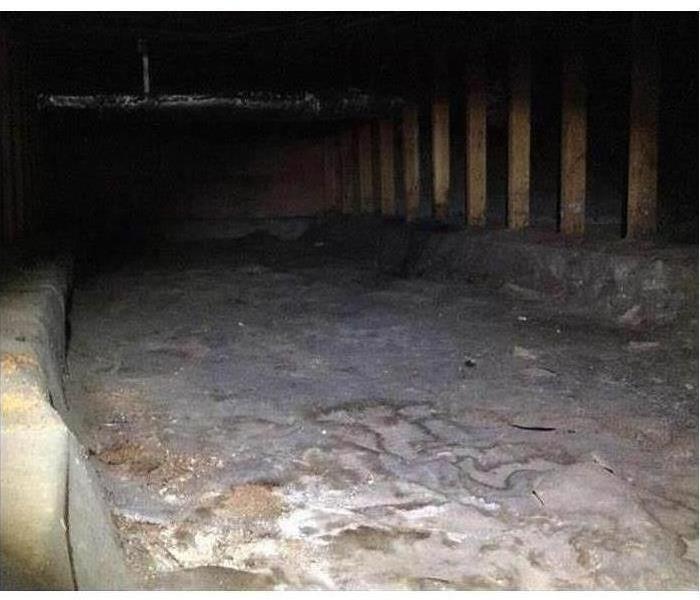 Avoiding structural damage and mold is essential to being a responsible homeowner.
Avoiding structural damage and mold is essential to being a responsible homeowner.
Recent record rainfall has created problems for home owners in the Olathe / Lenexa area. We experienced flooding this past year. Water has found its way into the crawlspaces of many area homes. Our technicians have responded to a large number of requests for services to dry out flooded crawlspaces.
Check your crawlspace for water damage
Even if you have not experienced flooding in your crawlspace in the past, it is always a good idea to do periodic inspections, especially after heavy rains, to insure the safety of your home.
Water intrusions in your crawlspace, left untreated, can cause structural damage and allow mold to grow in your home.
SERVPRO of Olathe / Lenexa technicians have the equipment and experience to take care of any water damage to your home, making it, “Like it never even happened.”
When Storms or Floods hit Olathe / Lenexa, SERVPRO is ready!
7/3/2019 (Permalink)
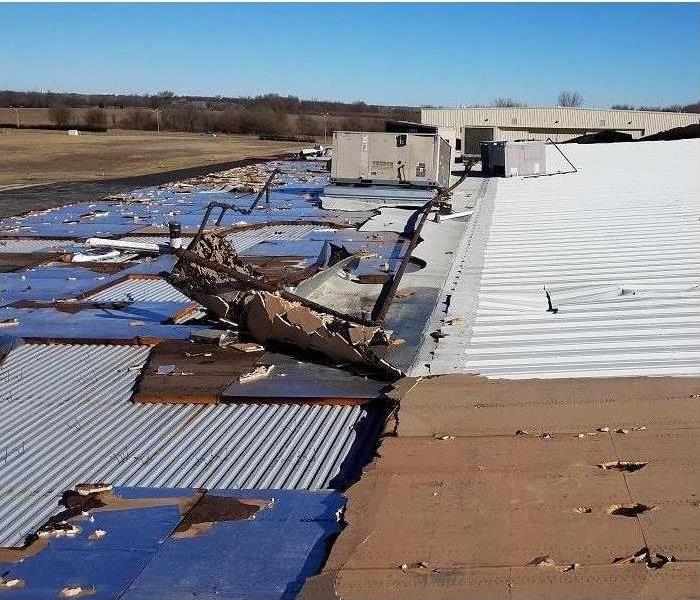 Our highly trained crews are ready to respond 24/7 to storm or flood damage in Olathe / Lenexa.
Our highly trained crews are ready to respond 24/7 to storm or flood damage in Olathe / Lenexa.
SERVPRO of Olathe / Lenexa specializes in storm and flood damage restoration. Our crews are highly trained and we use specialized equipment to restore your property to its pre-storm condition.
Faster Response
Since we are locally owned and operated, we are able to respond quicker with the right resources, which is extremely important. A fast response lessens the damage, limits further damage, and reduces the restoration cost.
Resources to Handle Floods and Storms
When storms hit Olathe / Lenexa, we can scale our resources to handle a large storm or flooding disaster. We can access equipment and personnel from a network of 1,650 Franchises across the country and elite Disaster Recovery Teams that are strategically located throughout the United States.
Have Storm or Flood Damage? Call Us Today 913-782-4693
3 Ways Property Managers Can Prepare for Storms
5/3/2019 (Permalink)
Focusing on Storm Preparedness
When you know that a storm is likely to impact your business in Gardner, KS, it’s easy to feel overwhelmed. However, focusing on storm preparedness before a disaster occurs can help to keep yourself, your staff and your property safe.
1. Document the Building’s State Before the Storm
When a building is damaged, it’s often important for property management to provide the business’ insurance company with documentation of the destruction. However, it may also be beneficial to have photographs of your property prior to the incident. By showing an insurance adjuster what the business looked like before it sustained damage, you can help to ensure your claim is accurate.
2. Establish a Line of Communication
Storms can come on suddenly, and in the event that the property needs to be evacuated, it’s useful to know how to contact all employees in a timely manner. As part of your storm preparedness plan, you may consider asking all staff members to provide you with a way to reach them quickly before a disaster. Since you may not be present in the building when an emergency occurs, it can also be wise to create a list of tasks that the last person to exit should perform. An example might include making sure all doors and windows are closed.
3. Inspect the Property
Inspecting the structure before a storm can help you prevent damage, because leaks or malfunctioning equipment may worsen any problems that do occur. An inspection will also allow you to observe any openings in the building, which can happen when roof shingles are cracked or missing. This may let rain get inside more easily. If you see signs of a problem, you should contact emergency restoration services to prevent additional issues.
As a property manager, storm preparedness can be an important element of your job. Documenting the building before a disaster, establishing a line of communication and inspecting the structure can help you to prepare your business for any situation.
The 4 Stages of Storm Damage Restoration
4/22/2019 (Permalink)
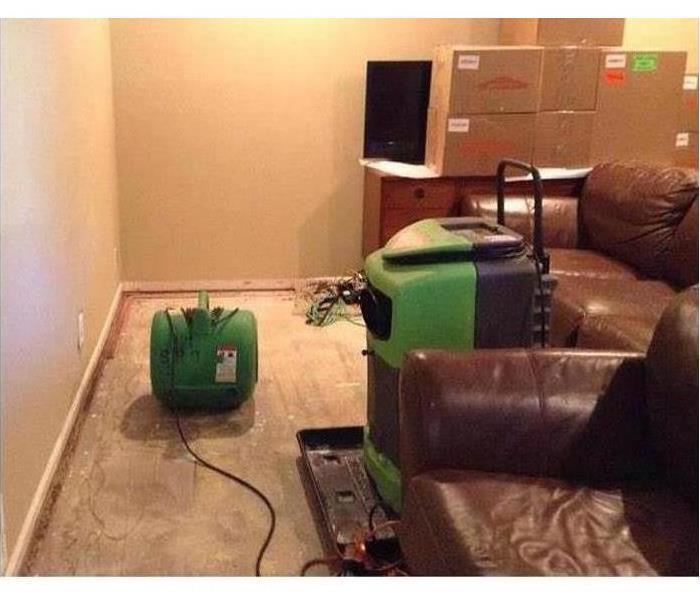 Homeowners must act quickly if adverse weather damages residences in Lenexa, KS.
Homeowners must act quickly if adverse weather damages residences in Lenexa, KS.
Homeowners must act quickly if adverse weather damages residences in Lenexa, KS. The restoration process may take several days, depending on the extent of damage and whether it is necessary to tear out and replace building materials or contents. Trained professionals can swiftly proceed through the four stages of storm damage restoration.
1. Mitigation
It is imperative to limit storm damage. Mitigation may involve tarping over a damaged roof, boarding up broken windows or other measures to prevent further damage.
2. Water Extraction
Water that is left standing for days will become increasingly contaminated and heighten the risk of mold. If a storm introduces Category Two gray water into a structure, this water can degrade into grossly contaminated Category Three black water within a matter of hours.
Homeowners may rent a pump to remove water or start the process by using a mop or wet vac. Damage mitigation professionals will be able to extract every trace of water and debris more quickly, which can limit water damage and help to prevent secondary damage.
3. Cleanup
It is important to remove debris as well as any damaged materials. It may be necessary to tear out porous building materials or contents saturated with contaminated water, as these materials may be difficult or impossible to clean completely. Every surface and item should be cleaned and disinfected to discourage mold growth.
4. Restoration
The affected area must be dry before restoration begins. The final stage of the process will involve rebuilding damaged portions of a structure and replacing discarded items.
It may take up to a week or longer to restore storm damage. An organized effort to extract water, tear out damage, clean and allow the affected area to dry may continue for several days. A homeowner in can limit the severity of storm damage by immediately contacting storm restoration specialists in Lenexa, KS.
Flood Insurance May Not Be an Option for Your Business
2/11/2019 (Permalink)
Flood Insurance May Not Be an Option for Your Business
You read that correctly. Flood insurance may not be an option. In some situations, it is a requirement. Financial institutions, investors and others expect you to protect their investments and property. They will not leave the insurance decision in your hands. Sometimes, it’s one of the costs of doing business.
Insurance companies distinguish between water damage and floods. Rising water causes flood damage.
Typical examples are:
- Overflowing rivers and streams
- Storm surge on large bodies of water
- Local flooding due to heavy rain or blocked storm drains
- Runoff from melting ice and snow
Weather, plumbing and fire sprinklers are common sources of water damage. A standard commercial insurance policy covers the cost of these repairs. It offers no coverage for floods. The following are situations that may require a business to have insurance.
1. The Federal Government funded, backed, or insured a business mortgage.
If your business is in a flood zone, the government requires you to have flood insurance. It’s the law. If a flood destroys the business, they want to get paid.
2. Other mortgage lenders may require the insurance.
Lenders want to protect their investment as well. They may even want the insurance for businesses near flood zones.
3. Investors may demand insurance.
If there is a flood, the investor’s investment is at risk. It is reasonable for them to expect the protection of their investment.
4. Certain customers and vendors may require insurance.
A distribution business ships inventory belonging to their customer. Other businesses may hold inventory consigned by a vendor. Both parties may want insurance protection for their inventory.
The Flood Happened and the Damage Is Extensive
That flood insurance sure was a great idea. The water is gone. Now, it’s a race against mold. There are flood and water damage remediation specialists in the Olathe, KS area. They can get you back on your feet quickly. Give them a call.
This Is No Time for a Swim: Staying Safe During and After a Flood
9/14/2018 (Permalink)
Do you know how dangerous flood water can be? A depth of 6 inches can sweep you away, and a depth of 12 inches can sweep your car away. Floods are fast-moving and aggressive, and if you didn’t heed the warnings to evacuate, then you need to know how to stay safe not just during the flood but after.
1. Staying Safe During
During a flood, you should stay in a safe location, and it is best to discuss this location with others so that when/if you need to be rescued your family can give first responders the most accurate information. Your safe place should be an elevated location. If you choose your house, do not go into the enclosed attic. The level you want should have numerous exit points so that the rising waters do not trap you. Additionally, when the flood begins, stay at your designated location. Do not attempt to leave, unless absolutely necessary because you could be at risk of drowning. Essentially, staying safe during a flood comes down to remaining calm and trying to stay above the rising water.
2. Staying Safe After
Standing flood water can be potentially hazardous. Not only do possible downed power lines present the risk of electrocution, but the water itself may also be contaminated from sewage and other debris. While a building was your sanctuary during the flood, a flooded building now presents serious health risks. If it is not possible to stay in a dry area, it may be wise to wear heavy gloves and boots to prevent contact with any potentially hazardous materials, but it is best to avoid contact if possible. When the time comes, you can seek out restoration specialists in the Olathe, KS, area to restore your home from any lasting water damage and to help with any hazardous cleanup.
Flooding and the resulting flood water are dangerous. It is never wise to ignore a call to evacuate, but it is not always possible to leave. When you must stay behind, it is essential to find high ground and avoid contact with contaminated materials. For more information, visit http://www.SERVPROolathelenexa.com/.
How do I Prevent Frozen Pipes?
7/28/2018 (Permalink)
Winter storms are often a problem for homes in Olathe, KS. Here are some tips on how to prevent having frozen pipes this winter.
- Keep garage doors closed if there are water supply lines in the garage.
- Open kitchen and bathroom cabinet doors to allow warmer air to circulate around the plumbing. Be sure to move any harmful cleaners and household chemicals up out of the reach of children.
- When the weather is very cold outside, let the cold water drip from the faucet served by exposed pipes. Running water through the pipe - even at a trickle - helps prevent pipes from freezing.
- Keep the thermostat set to the same temperature both during the day and at night. By temporarily suspending the use of lower nighttime temperatures, you may incur a higher heating bill, but you can prevent a much more costly repair job if pipes freeze and burst.
- If you will be going away during cold weather, leave the heat on in your home, set to a temperature no lower than 55° F.
How to Protect Pipes From Freezing
7/28/2018 (Permalink)
Before the onset of cold weather, protect your pipes from freezing by following these recommendations:
- Drain water from swimming pool and water sprinkler supply lines following manufacturer's or installer's directions. Do not put antifreeze in these lines unless directed. Antifreeze is environmentally harmful, and is dangerous to humans, pets, wildlife, and landscaping.
- Remove, drain, and store hoses used outdoors. Close inside valves supplying outdoor hose bibs. Open the outside hose bibs to allow water to drain. Keep the outside valve open so that any water remaining in the pipe can expand without causing the pipe to break.
- Add insulation to attics, basements and crawl spaces. Insulation will maintain higher temperatures in these areas.
- Check around the home for other areas where water supply lines are located in unheated areas. Look in the garage, and under kitchen and bathroom cabinets. Both hot and cold water pipes in these areas should be insulated.
- Consider installing specific products made to insulate water pipes like a "pipe sleeve" or installing UL-listed "heat tape," "heat cable," or similar materials on exposed water pipes. Newspaper can provide some degree of insulation and protection to exposed pipes – even ¼†of newspaper can provide significant protection in areas that usually do not have frequent or prolonged temperatures below freezing.
- Consider relocating exposed pipes to provide increased protection from freezing.
Your Guide To Quickly and Effectively Cleaning Up Post-Flood
7/24/2018 (Permalink)
A flood can wreak havoc on your home's structure, belongings, and even your home's environment, as the water can carry contaminants and mud. For this reason, it is imperative that you begin content cleaning efforts as soon as the waters recede, or as soon as the influx of water has stopped. The more time you take to begin cleanup efforts, the greater the chance that your home and belongings will experience irreversible damage.
Floods can damage everything from carpeting to furniture and from your home's ductwork to its HVAC system. If you want to minimize damage and restore your home to normal, there are particular areas to which you must pay attention:
• Ceilings and walls
• Electrical systems
• Heating and cooling systems
• Appliances
• Carpeting, vinyl and wood floors
• Sewage systems
Content Cleaning Tips.
Though the majority of flood cleanup should be left to the professionals (especially if gray or black water is involved), there are a few steps you can take before your local Olathe, KS, water restoration team shows up. First, contact your insurance company. If your homeowners' insurance policy covers the damage, an adjuster will be in contact with you.
Once you've made the necessary phone calls, begin to shovel mud out of your home. If a garden hose reaches the flooded area, you can use the hose to spray mud away. Once the mud is gone, start sanitizing. Scrub surfaces with hot water and a heavy-duty cleaner. Soak belongings that can be soaked in a mixture of hot water and chlorine bleach. If the items in question are metal, such as silverware or pots and pans, simply let them sit in boiling water for 10 minutes.
Take any rugs and furniture outside to air dry and use a dehumidifier and fans to remove moisture from the air. You can also begin to toss smaller, contaminated items, such as toys, stuffed animals, and food.
Ideally, you should leave the deep content cleaning to the professionals, as professional flood restoration teams know what is salvageable and what is not. Moreover, experts have the necessary safety equipment to restore your home to a pre-flood condition.
For more information, please visit us at http://www.SERVPROolathelenexa.com/.
Steps to Reduce the Risk of Tornado Damage in Olathe
5/9/2018 (Permalink)
Tornado damage mitigation tips from Disastersafety.org.
About 1,000 tornadoes occur each year in the United States, causing an average of $1.1 billion in property damage and 80 deaths. These storms vary in intensity and the accompanying damage can result in everything from minor repairs to complete destruction with little warning. Most tornadoes are relatively weak, and therefore, primarily damage roofs, windows and trees. While only two percent of tornadoes achieve the most violent and damaging classification, one quarter of tornadoes are powerful enough to cause 90 percent of the damage and two-thirds of the deaths.
In an effort to gain a better understanding of who is most at risk from these destructive forces, the Insurance Institute for Business & Home Safety (IBHS) conducted a regional analysis of tornadoes of F2 or greater strength that were reported during the 50-year period beginning in 1957 through 2006. This analysis, coupled with the construction guidance included below, is intended to better define which areas are most likely to be affected by tornadoes and to suggest methods for mitigating property risks.
The analysis used tornado records from a period of time when the older Fujita Scale classification F0 through F5 was being used. Since 2006, tornadoes have been classified by the Enhanced Fujita Scale using EF0 through EF5. Both scale classifications are based on damage observed after a tornado strikes. The EF scale, which provides a larger number of damage indicators for different types of buildings, attempts to recognize the difference between poorly constructed and well constructed buildings and results in lower estimates of wind speeds for the most intense storms, which are classified using the highest number on the F or EF scales. Efforts to re-classify the older F-Scale tornadoes using the EF-Scale are very labor intensive and subject to judgment because it requires a review of old damage reports, many of which will not have pictures of the damage. The simple approach, which is reasonable and probably slightly conservative, is to simply use the new wind speed estimates with the older classifications.
In creating the map below, IBHS used a grid of 100 square mile cells in the analysis. This is a smaller cell size than used by most other analyses. The advantage is a finer resolution of tornado risks at the expense of greater variability between adjacent cells. The effects of this potential limitation were reduced by employing a process to smooth out differences in tornado frequencies between nearby cells.
Tornadoes have a unique destructive power among wind-related natural disasters because they concentrate a massive amount of energy in a relatively small area. The strongest category of tornadoes can generate maximum wind speeds of greater than 250 mph, which is enough to destroy most buildings and structures in their path. These maximum wind speeds generate forces that are about twice as large as those generated by the strongest hurricanes.
Only a few specialty buildings are designed to withstand the direct impact of a severe tornado. However, well engineered, large and tall commercial structures are not likely to suffer structural collapse. For smaller commercial structures, good construction choices can give added protection and increase the likelihood that at least part of the structure will remain standing to provide shelter. Buildings that have been strengthened in critical areas and particularly at connection points, such as between the roof and walls and walls and foundation, would have a good chance of surviving intact or with minor cosmetic damage if subjected to the outer edges of a tornado.
Despite the annual tornado exposure, many walls and roofs of businesses in inland areas of the United States are typically built to resist gravity loads and have little resistance to uplift and lateral loads. Construction where all parts of the building are well connected is more common in hurricane-prone areas, but should also be considered by anyone who wants to increase their property’s protection from other severe windstorms, according to the building science experts at IBHS.
A CHECKLIST FOR MITIGATING TORNADO RISKS
While there is no way to eliminate all the damage of a direct hit from a violent tornado, businesses in tornado-prone areas can implement a variety of affordable measures which, for the majority of tornadoes, will effectively minimize damages to facilities, injuries to employees and the losses associated with business disruptions.
While the measures below focus specifically on tornado risks, many also will help protect businesses from other types of high wind and thunderstorm-related weather risks outside of tornado-prone regions.
ASSESS THE LIKELIHOOD OF A TORNADO STRIKING YOUR BUSINESS
Is the area where you live and work prone to tornadoes? Look at the map in this report to identify areas with the highest risk of tornadoes. Knowing what tornado risks are present is essential for choosing the appropriate mix of measures to protect your business. Businesses located in areas with a heightened tornado risk should take the following steps to minimize their risk of tornado damage:
PROTECT YOUR EMPLOYEES
- Prepare and disseminate an emergency plan describing what supervisors and employees should to do as a tornado threatens. Practice these procedures through tornado drills.
- Purchase a weather radio with local discrimination capability. Monitor weather conditions so employees can be moved to secure locations when necessary:
- Have an adequate source of weather information, such as a tone alert weather radio, to keep abreast of weather conditions.
- Have someone monitor local radar and warning information during a tornado watch and especially if a tornado warning has been issued for the area.
Watches and Warnings:
- A tornado watch is a caution indicating a high probability of tornadoes within an area approximately 250 miles long and 120 miles wide.
- A tornado warning means that a tornado has been spotted on the ground in your county or moving toward your county, or that weather radar indicates a high probability of a tornado existing.
- Keep exterior doors and windows closed to minimize rain and flying debris. Closing interior doors will also help to compartmentalize the building and provide more barriers between your employees and the storm.
- Select the best protective area for employees to seek shelter if there is a tornado:
- Basements are usually considered a good area, as are corridors and small interior rooms on the first floor of a structure.
- Never shelter employees in rooms where there is an outside wall, particularly those with glass windows, or where the ceiling or roof has a span between supports of more than 40 feet.
- If your building does not provide adequate protection and you are located in a tornado prone area, work with a contractor to harden a section of your facility or build a safe room.
- Safe Rooms: The Federal Emergency Management Agency (FEMA) and International Code Council (ICC) offer shelter guidelines.
- If you have 10 or fewer employees, a small size room designed according to the requirements and guidance published in FEMA 320 or ICC 500 for residential shelters may be sufficient.
- For larger safe rooms, use FEMA 361 or ICC 500 guidance for community shelters.
Make provisions to shelter employees working in portable out buildings and those operating trucks and other vehicles.
PROTECT YOUR PROPERTY
Wind-resistant construction can be cost effective and minimize the risk of structural damage for the majority of tornadoes, particularly damage from weak to moderate tornadoes, hail and wind associated with thunderstorms, and even to buildings on the edge of strong or violent tornadoes:
For new construction in a tornado prone area:
- Work with an architect or contractor to incorporate wind mitigation techniques and high wind-rated products when constructing your building, including safe areas for personnel.
- These techniques provide state-of-the art solutions to minimize structural risks by withstanding pressures created by specified high winds, strengthening roof and wall connections, roof systems, walls and wall covering, windows, doors, and skylights.
- It is less costly and more effective to harden buildings during design and construction rather than later.
For an existing structure, not built to wind mitigation standards:
- Consider retrofitting, especially when remodeling or replacing building components.
- Retrofitting may include:
- Bracing and strapping the roof.
- Adding recommended fasteners, ties, reinforcements, roof covering and anchors as building components are modified and maintained.
- Making entry doors and overhead doors more wind-resistant.
- Building a safe room to protect against tornadoes.
- For additional information on protection for existing buildings, see “Protecting Commercial Property” in the Tornado section of our website www.DisasterSafety.org.
MINIMIZE THE THREATS FROM WIND-BORNE DEBRIS
- Identify and remove trees and branches that could fall on the building walls or roof, or on power lines.
- Inspect and repair loose or damaged building components such as siding, soffit and fascia, shingles and roofing, brickwork, and brick chimneys.
- Avoid using built -up roofs with aggregate or pavers on the surface.
Visit www.DisasterSafety.org/tornado to find additional details and how-to instruction for many of these projects.
April Showers Bring May Flowers and More...
4/25/2018 (Permalink)
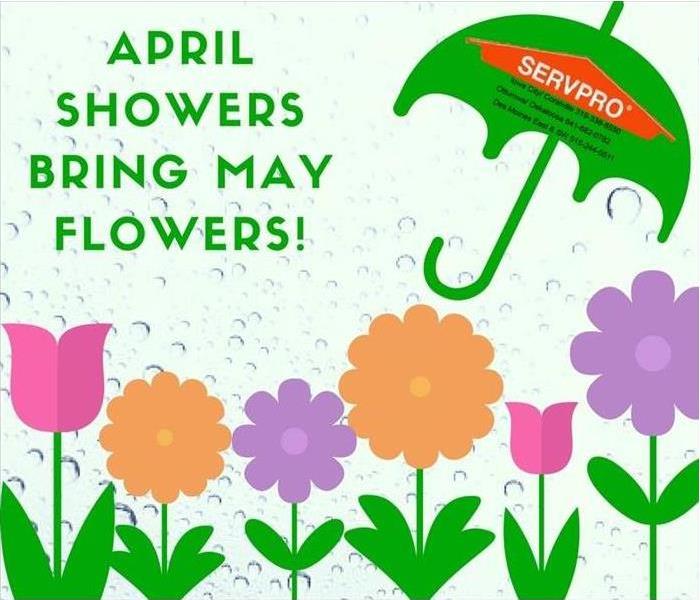 April showers bring May flowers and more...
April showers bring May flowers and more...
April showers help to bring us the most vibrant May flowers and we are so happy with this change of season. However, when April showers are more like torrential, relentless downpours we could face a flooded basement and other water damage causing costly repairs. Flooding generally occurs in the springtime as the result of heavy rains that cannot be adequately absorbed by the still thawing earth. Particularly formidable are the flash floods resulting from thunderstorms, swiftly melting snow and ice jams in creeks. Consider if more than one of these circumstances happens at the same time, you have the potential for a catastrophe with flooding waters and raging mudslides.
Homeowners you can take some simple precautions to secure your property and keep your possessions safe.
Elevate: Keep your furnace, water heater, electrical panels above predicted water levels to protect yourself from costly home replacements.
Install check valves: These valves close to prevent the backward flow of liquid and prevent water from backing up into the drains in your home.
Build barriers: Use sandbags to create flood walls to prevent or reduce flow of water into your home.
Waterproof the basement: Use a waterproofing compound to seal the walls of your basement.
Clean: Clean gutters, drains and downspouts for proper water flow.
Purchase flood insurance: Most standard homeowners' and business insurance policies unfortunately do no cover flood damage. In the event of a flood, you would be responsible for covering the full cost of repairs and replacing items damaged.
There is help close by should you experience an unfortunate event with your home or business. Contact SERVPRO of Olathe / Lenexa at 913.782.4693. We are trained storm specialists who will come in and quickly get your home or business back to a safe and healthy environment. We have the specific training and certifications to handle your restoration needs provided by an Applied Microbial Remediation Specialist, a Water Damage Restoration Technician, and an Applied Structural Drying Technician. We provide emergency cleaning and restoration services 24 hours a day, 7 days a week—including all holidays. You can expect an immediate response time, day or night.






 24/7 Emergency Service
24/7 Emergency Service















